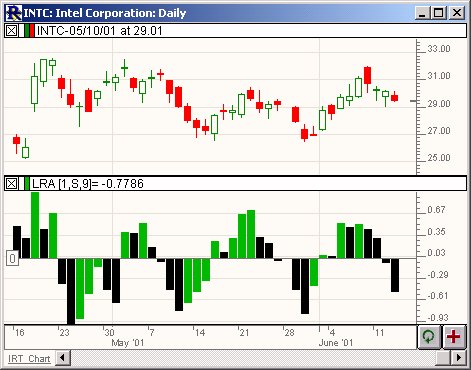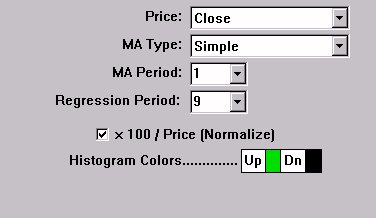First, the data, based on the price selected, is smoothed using the moving average period and type. If you prefer no smoothing, choose a period of 1 here. The resulting data is then used to form regression lines ending at each bar, using the regression period specified. The linear regression acceleration of each bars regression line is then recorded as the change in slope of the regression line from the slope of the regression line of the previous bar. For instance, using the preferences specified above, the raw closing price would be used (smoothing period of 1). Then, using that resulting data, for each bar, we would us that bar and the previous 8 bars (9 total) to form a regression line. The LRA of that bar is then recorded as the difference between that regression lines slope and the slope of the regression line of the previous bar.. The same calculation is done for each bar and then plotted in the chart, as a histogram or a line.
If the "x 100 / Price (Normalize)" options is checked, then the resulting value will be the change in normalized slope per bar. This normalizes the data for the sake of comparison among instruments that trade in different price ranges. If you are interested in using this study to compare acceleration between instruments, it's important that this normalizing option be used. The difference between the normalized acceleration and the raw acceleration is similar to the difference between percent change (normalized), and change(unnormalized). If you're comparing two instruments, one that's trading at 200 and another that's trading at 10, then it's not fair to compare the change in price, although the normalized value of percent change does give us a fair basis of comparison.
The normalized acceleration value essentially gives us the change is the normalized slope of the regression (best fit) line, from bar to bar. If the normalized acceleration is 0.10, then the regression line normalized slope is rising at a rate of 0.10 per bar. Similarly, a normalized acceleration of -0.25 would indicator that the normalized slope of line that best fits the last N bars of data is falling at the rate o 0.25 per bar. For example, if the normalized slope of the last bar was 0.25 (meaning the regression line ending on that bar rises at a rate of 0.25% per bar on average), and the normalized slope of the current bar was 0.27, then the normalized acceleration of the current bar would 0.27 - 0.25 = 0.02. A positive acceleration value does not equate to a positive slope, simply to an increasing slope. Similarly, a negative acceleration equates to a decreasing slope.
Presentation

Above is a Daily Candlestick Chart of an Intel Corporation (INTC). The Linear Regression Acceleration (LRA) is drawn in histogram form in the lower chart pane. The LRA oscillates about the zero line.
See Also
Formula
Keyboard Adjustment
The periods involved in the LRA indicator can be adjusted directly from they keyboard without opening the preferences. Select the indicator, then use the up and down arrow keys to adjust the regression period up or down by 1. To adjust the MA period, hold down the shift-key while pressing the up and down arrows


